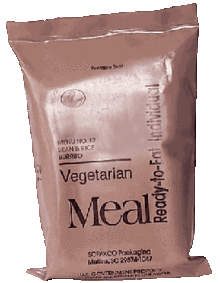Retort pouch

A retort pouch is a type of food packaging made from a laminate of flexible plastic and metal foils. It allows the sterile packaging of a wide variety of food and drink handled by aseptic processing, and is used as an alternative to traditional industrial canning methods. Packaged foods range from water to fully cooked, thermo-stabilized (heat-treated) high-caloric (1,300 on average) meals such as Meals, Ready-to-Eat (MREs) which can be eaten cold, warmed by submersing in hot water, or through the use of a flameless ration heater, a meal component introduced by the military in 1992.[1] Retort pouches are used in field rations, space food, camping food, and brands such as Capri Sun and Tasty Bite.
Some varieties have a bottom gusset and are known as Stand-Up Pouches.
Origin
The retort pouch was invented by the United States Army Natick R&D Command, Reynolds Metals Company, and Continental Flexible Packaging, who jointly received the Food Technology Industrial Achievement Award for its invention in 1978.[2] Retortable pouches are extensively used by the U.S. military for field rations (called Meals, Ready-to-Eat, or MREs).
Construction
A retort pouch is constructed from a flexible metal-plastic laminate that is able to withstand the thermal processing used for sterilization. The food is first prepared, either raw or cooked, and then sealed into the retort pouch. The pouch is then heated to 240-250°F (116-121°C) for several minutes under high pressure inside a retort or autoclave machine. The food inside is cooked in a similar way to pressure cooking. This process reliably kills all commonly occurring microorganisms (particularly Clostridium botulinum), preventing it from spoiling. The packaging process is very similar to canning, except that the package itself is flexible. The lamination structure does not allow permeation of gases from outside into the pouch. The retort pouch construction varies from one application to another, as a liquid product needs different barrier properties than a dry product, and similarly an acidic product needs different chemical resistance than a basic product. Some different plastic layers used in retort pouches include:
- polyester (PET) – provides a gloss and rigid layer, may be printed inside
- nylon (bi-oriented polyamide) – provides puncture resistance
- aluminum (Al) – provides a very thin but effective gas barrier
- food-grade cast polypropylene (CPP) – used as the sealing layer
- polyethylene (PE) – can be used instead of PP as a sealing and bonding layer
This multi-layer structure prevents the retort pouch from being recycled into other retort pouches or food packaging. However, the material can be recycled into an aluminized resin or up-cycled into textile materials.[3] The weight of a pouch is less than regular cans or bottles, and the energy required to produce each pouch is less than competing packaging from metals, paper, and glass.
Reception
In the consumer market, retort pouches have gained great popularity outside of the United States, particularly in the Pacific Rim region. However, American consumers have evidently demonstrated reluctance regarding the packaging technology, and its adoption has been slow. As a result, many retort packages sold in the United States are packaged in cartons to give them an appearance more familiar to consumers. Tasty Bite products are an example of a retort pouch product packaged in a carton. Several American food distributors have begun manufacturing foods in retort pouches without cartons, notably tuna canning companies Chicken of the Sea, and Bumble Bee. In 2012, the Campbell Soup Company introduced its Go line of ready-to-eat soups in stand-up retort pouches to American consumers. The product launch came with a marketing campaign targeted toward Millennials, who have shown reluctance to purchasing other Campbell Soup products in the past.[4]
References
- ↑ Combat Index, “Meals Ready to Eat.” http://www.combatindex.com/. Retrieved on February 6, 2008
- ↑ (Food & Drug Packaging) Retort pouches build up steam: big food companies are taking advantage of technical advances to bring out retorted products in flexible material - Technology: retort packaging
- ↑ "Why Flexible Packaging | Maco PKG". Maco PKG. 2015-06-29. Retrieved 2016-11-03.
- ↑ http://www.forbes.com/sites/jennagoudreau/2012/12/06/kicking-the-can-campbells-ceo-bets-on-soup-in-a-bag-for-20-somethings/
- Yam, K. L., "Encyclopedia of Packaging Technology", John Wiley & Sons, 2009, ISBN 978-0-470-08704-6